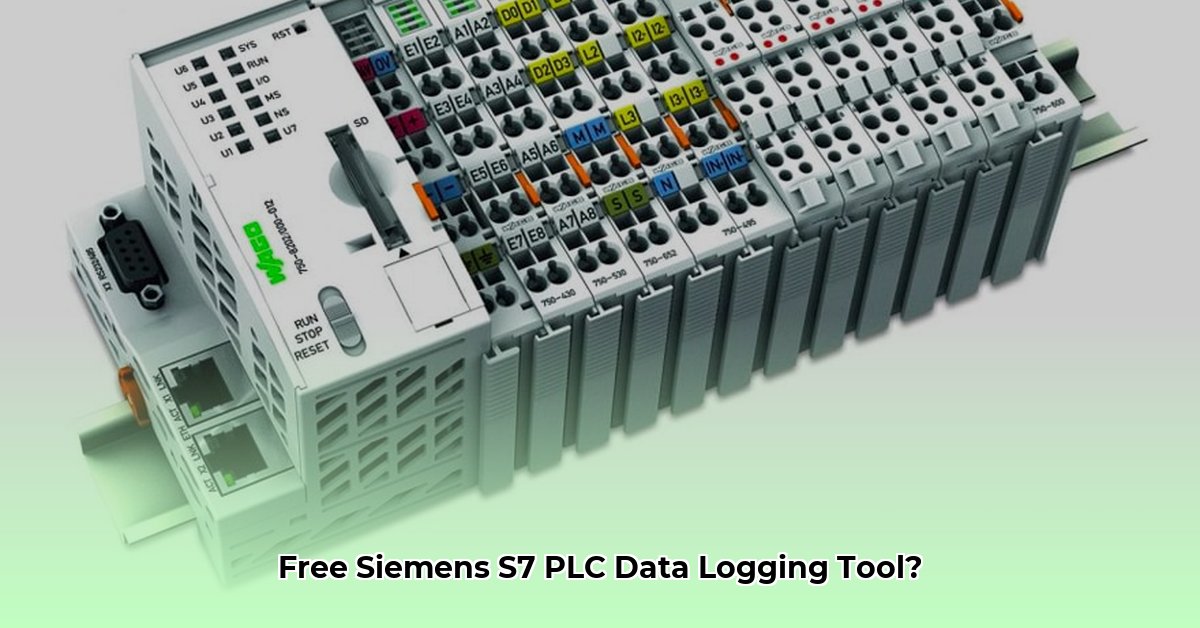This guide provides a complete walkthrough of SPS Logger, a free tool designed for logging data from Siemens S7 PLCs. Whether you’re a seasoned programmer or just starting out with PLCs, this guide will equip you with the knowledge to effectively use SPS Logger for monitoring, troubleshooting, and optimizing your PLC systems.
What is SPS Logger?
SPS Logger acts as a real-time window into your Siemens S7 PLC (including S7-200/S5, S7-300/400, and potentially others via OPC UA). It translates complex PLC data into a user-friendly visual format, making it easier to diagnose issues, understand system behavior, and optimize performance. By leveraging the libnodave library, SPS Logger establishes communication with your PLC, effectively “listening” to the data streams. It excels at providing an immediate overview of your PLC’s operations. While it isn’t designed for long-term data archiving or in-depth statistical analysis, its strength lies in real-time monitoring and visualization. The software is regularly updated, with the latest versions introducing features like OPC UA support, suggesting expanded compatibility with a wider range of PLCs beyond Siemens. However, the full extent of this compatibility is still being explored.
System Requirements and Download
Before installing SPS Logger, ensure your system meets the following requirements:
| Requirement | Details |
|---|---|
| Operating System | Windows 7, 8, or 10 (an older version is available for Windows XP). |
| .NET Framework | Version 4.7.2 (x86 and x64) – automatically installed if not present. |
| SQL Server LocalDB | 2014 SP1 Express edition – automatically installed if not present. |
| Disk Space | A few megabytes. |
To download the latest version of SPS Logger, visit the official website (locate via a web search for “SPS Logger download”). The download file is typically named setup.exe. The official documentation and community forums are valuable resources for staying updated on the latest releases and features.
Installing SPS Logger
The installation process is straightforward, utilizing a ClickOnce installer for simplified updates:
-
Locate and run: Double-click the downloaded
setup.exefile. -
Security: If a ClickOnce security warning appears, click “More info” and then “Run anyway”.
-
Follow the wizard: The installer will guide you through the process. Accept the license agreement and choose an installation location (the default is usually fine).
-
Automatic installations: The installer will automatically install .NET Framework 4.7.2 and SQL Server 2014 SP1 Express LocalDB if they’re not already present on your system.
-
Launch: After installation, launch SPS Logger to begin configuration.
Connecting to Your PLC
Connecting SPS Logger to your PLC involves configuring communication parameters:
-
Gather PLC information: Obtain your PLC’s IP address, rack number, and slot number. This information is typically found in your PLC documentation.
-
Enter parameters: In the SPS Logger interface dedicated to connections (the exact location may vary slightly with different versions of SPS Logger), enter the collected PLC information.
-
Test connection: SPS Logger probably provides a way to test the connection. This helps confirm that the parameters are correct and communication is established.
Consult the SPS Logger documentation or online resources for visual diagrams or further assistance with the connection process.
Using SPS Logger
The SPS Logger interface allows you to select specific data points (variables/tags) from your PLC to monitor in real-time. You can likely configure logging parameters such as sampling rate and trigger events. The software may also provide data visualization options and export functionalities. The interface will evolve with future updates; always prioritize consulting official SPS Logger documentation for the most accurate and up-to-date interface instructions.
Android Companion App (If Available)
If an Android companion app exists, it will probably allow you to remotely monitor PLC data. Download it from the Google Play Store (if available) and follow the app’s instructions to connect to your SPS Logger instance running on Windows. The app’s functionality might include real-time data viewing and notifications.
Troubleshooting
If you encounter issues:
- Connection Problems: Double-check your PLC network settings and cable connections. Consult your PLC’s documentation for network setup instructions.
- Data Not Displaying: Verify that you’ve selected the correct data points within SPS Logger and that the connection is active.
- App Issues: Ensure the Windows application is running and your mobile device has a stable network connection.
Check the SPS Logger website for FAQs and further troubleshooting guidance.
Advanced Tips and Tricks (Optional)
As you become more familiar with SPS Logger, explore its advanced features, such as customized visualizations, scripting, or advanced filtering, if available. Refer to the official documentation for in-depth explanations and examples.
Alternatives to SPS Logger
While SPS Logger is a powerful free tool, consider these alternatives:
- Libnodave: A more code-centric approach, offering greater flexibility for developers.
- Commercial PLC Logging Software: Paid options like “PLC-Logger” (and others) offer more advanced features and support but come with a cost. Research various options to find the right fit for your needs.
Conclusion
SPS Logger provides a readily accessible way to gain valuable insights into your Siemens S7 PLC data. By understanding its functionalities and following the guidelines in this guide, you can leverage this free tool for effective PLC monitoring, troubleshooting, and optimization. Remember to continue exploring the official documentation and user community to stay abreast of evolving features and insights.
- Wind Power Energy Advantages: Clean, Domestic And Cost-Effective Power - November 12, 2025
- Wind Turbine Pieces: Examining The Industrys Future Growth - November 9, 2025
- Wind Turbine Installation: Building the Future of Energy - November 7, 2025
















